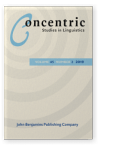Vol. 45:2 (2019) ► pp.192–210
Two types of possessive passives in Japanese
Many East Asian languages have possessive passives, whose subjects are interpreted as the possessor of the direct object. This paper investigates Japanese Possessive Passives (JPPs) and proposes that there are two types of possessive passives in Japanese: one with a ‘by-phrase’ headed by ni (ni JPPs) and the other with a ‘by-phrase’ headed by ni yotte (ni yotte JPPs). While previous studies assumed that JPPs are a sub-type of indirect passive, I propose that such an analysis is untenable. Instead, JPPs exhibit the same dichotomy as ni-passives and ni yotte-passives exhibit (Kuroda 1979, Kitagawa & Kuroda 1992): While subjects of ni JPPs are base-generated like ni-passives, subjects of ni yotte JPPs undergo NP movement like ni yotte-passives.
Article outline
- 1.Introduction
- 2.Differences between ni JPPs and ni yotte JPPs
- 3.Proposal
- 4.Arguments for an affected argument in JPPs
- 5.Solution to the two issues
- 6.Arguments against the possessor raising analysis
- 7.Null operator in ni JPPs
- 8.Remaining issues
- 9.Conclusion
- Acknowledgements
- Notes
-
References
